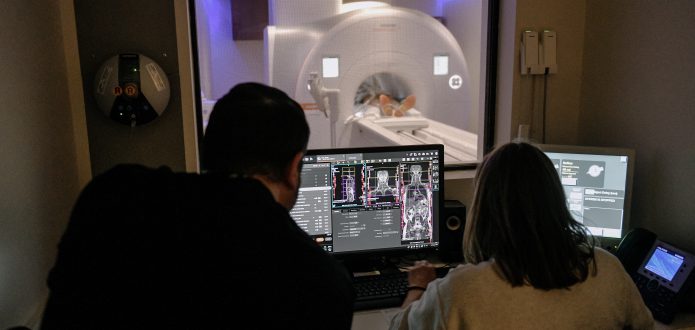West Cancer Center & Research Institute’s Radiology department consists of a team of Board Certified Diagnostic and Interventional Radiologists. We perform minimally invasive procedures using image-guided technology to diagnose and treat patients non-surgically, resulting in shortened procedure and recovery time, and often, with lower risk and pain.
Diagnostic Radiology Services
Diagnostic Radiology (DR) uses imaging exams and procedures to diagnose your specific disease. It is at the core of clinical decision-making in modern medicine.
- Axumin PET imaging
- CT
- DEXA Bone Scan
- Lung Screening
- MRI (Magnetic Resonance Imaging)
- NetSpot Scan
- PET (Positron Emission Tomography)
- X-Ray
- Ultrasound
- Y-90
Interventional Radiology Services
Interventional Radiology (IR) refers to a range of techniques which rely on the use of radiological image guidance (x-ray fluid, ultrasound, CT, or MRI) with a precisely targeted therapy. Most IR treatments are minimally invasive alternatives to open and laparoscopic surgery. Well recognized advantages of these minimally invasive techniques include reduced risks, shorter hospital stays, lower costs and greater comfort. The effectiveness of these treatments is often better than traditional therapies.
- Abscess Drainage
Using imaging guidance, a needle or catheter is placed through the skin into the abscess, an infected collection of fluid, to remove or drain the infected fluid. It offers faster recovery than open surgical drainage.
- Arterial Embolization
This procedure reduces or blocks the blood flow to the liver through the hepatic artery, where cancer in the liver is mainly fed, leaving the healthy liver cells unharmed
- Biliary Interventions
Biliary interventions treat blockages, narrowing and/or injury of the passages between the liver, gallbladder and small intestine called bile ducts. Bile is produced in the liver and stored in the gallbladder where it can be released into the small intestine to aid in digestion. If the bile ducts become blocked, it may lead to inflammation or infection also known as sclerosis cholangitis. Biliary interventions may remove gallstones, drain excess bile or place a stent within a bile duct to treat your condition and restore the flow of fluids.
- Gastrostomy Placements
This is a procedure is where a feeding tube is placed through the skin and stomach wall either endoscopically, with a small scope, or radiologically.
- Inferior Vena Cava Filter Placements / Retrievals
For patients that don’t respond to or can’t be given convention medical therapy, like blood thinner, IVC filters can trap large clots to keep them from reaching the heart or lungs. IVC is a large vein in the abdomen that returns blood from the lower half of the body to the heart and these filters reduce the risk of blood clots in the lower region traveling to the heart or lungs.
- Paracentesis / Thoracentesis
If fluid builds up in the chest making it difficult to breath, a thin needle can be inserted using ultrasound to drain the excess fluid (Thoracentesis). The same procedure can be used to reduce fluid in the abdominal cavity (Paracentesis) which causes pain and pressure on internal organs.
- Nephrostomy and other Kidney Interventions
If the tube that passes urine from the kidney to the bladder, the ureter, becomes blocked, an opening can be created between the kidney and the skin to temporarily drain the urine that is blocked through a thin plastic tube attached to a drainage bag. This is necessary for proper kidney function and to protect from damage.
- Port Placements
To make treatments easier if you are receiving chemotherapy, blood transfusions, antibiotics or any other intravenous fluid, a narrow, long, hollow tube made of soft plastic (port) may be placed into the vein.
- Uterine Fibroid Embolization
Fibroid tumors of the uterus many times cause pressure, pain and heavy bleeding. UFE uses x-ray guidance to deliver a blocking agent through a small tube (catheter) to the uterus and fibroids to stop blood flow and cause them to shrink.
Cancer Treatments
Many image guided techniques can be used to treat cancer. Blocking off blood supply, heat, freezing, or using radiation are several of the options used to destroy the disease.
- PVE (Portal Vein Embolization)
This procedure is used for primary liver cancer and colorectal liver metastases. A needle is placed through the skin into the liver to the blood vessel on the side where the largest part of the tumor is being supplied. The blood supply is cut off with tiny microspheres that are infused into the portal vein.
- SIRT (Selective Internal Radiation Therapy)
This procedure is also for liver cancers where tiny radioactive microspheres are delivered directly to the tumor through a small incision in the groin through a small tube.
- Tumor Embolization
This minimally invasive procedure is usually done prior to surgical removal to stop the blood supply the tumor and reduce blood loss during surgery. For cancers that have a large blood supply like; spine, head and neck, this technique is beneficial.
- Radioembolization (Y90)
This minimally invasive procedure combines radiation therapy with arterial embolization, injecting a substance directly into the artery in the liver to block or reduce the blood flow to the tumor in the liver. Tiny glass or resin beads filled with the radioactive isotope yttrium Y-90 are placed inside the blood vessels that feed a tumor. This blocks the supply of blood to the cancer cells and delivers a high dose of radiation to the tumor while sparing normal tissue. It can help extend the lives of patients with inoperable tumors and improve their quality of life.
- Tumor Ablation
Using Computed Tomography (CT), Ultrasound (US), or Magnetic Resonance Imaging (MRI), a small needle is inserted directly to the tumor and either “burned” or “frozen” to kill the cancer cell. This technique can be performed with conscious sedation and is most commonly used for lung, liver and kidney cancer.
Pain Management
Diagnostic injections and pain procedures can help treat acute and chronic pain. They are ordered for the diagnosis and/or treatment of pain in many areas of the spine and joints (lumbar, cervical, thoracic, shoulder, hip, wrists, etc.). Often times, you may receive an MRI or CT exam in conjunction with a pain management injection. Our radiologists specialize in pain management procedures, ensuring your pain injection is both safe and accurate.
- Kyphoplasty / Vertebroplasty
To relieve back pain caused by a spinal compression fracture, either bone cement is injected in the fractured bone (Vertebroplasty) or a balloon is inserted to create space and then filled with cement (Kyphoplasty). An endoscope, or small scope is used for image guidance.
- Joint Injections
A small needle injects a medication into the joint to provide relief for pain and swelling.
- Nerve Blocks
This procedure is where a local anesthetic (a numbing drug), often combined with a steroid, is injected into or around a nerve or into the space around the spinal cord to block pain. After the injection, the nerve is no longer able to relay pain so the pain is relieved for some time. For longer-lasting pain relief, phenol or alcohol can be injected.
Our Radiology Providers

Allen Ardestani, MD, PhD
Diagnostic Radiologist

Scott Baum, MD
Interventional Radiologist

Michael Doherty, MD
Interventional Radiologist

Jeffrey Green, MD
Diagnostic Radiologist

Daniel Powell, MD
Diagnostic Radiologist

Sridhar Shankar, MD
Diagnostic Radiologist

Evan Swift, PA
APP-Interventional Radiology

Bethany Kelley, NP
APP-Interventional Radiology

Learn more about how to schedule an appointment or refer a patient to our oncology specialists here at West Cancer Center.

